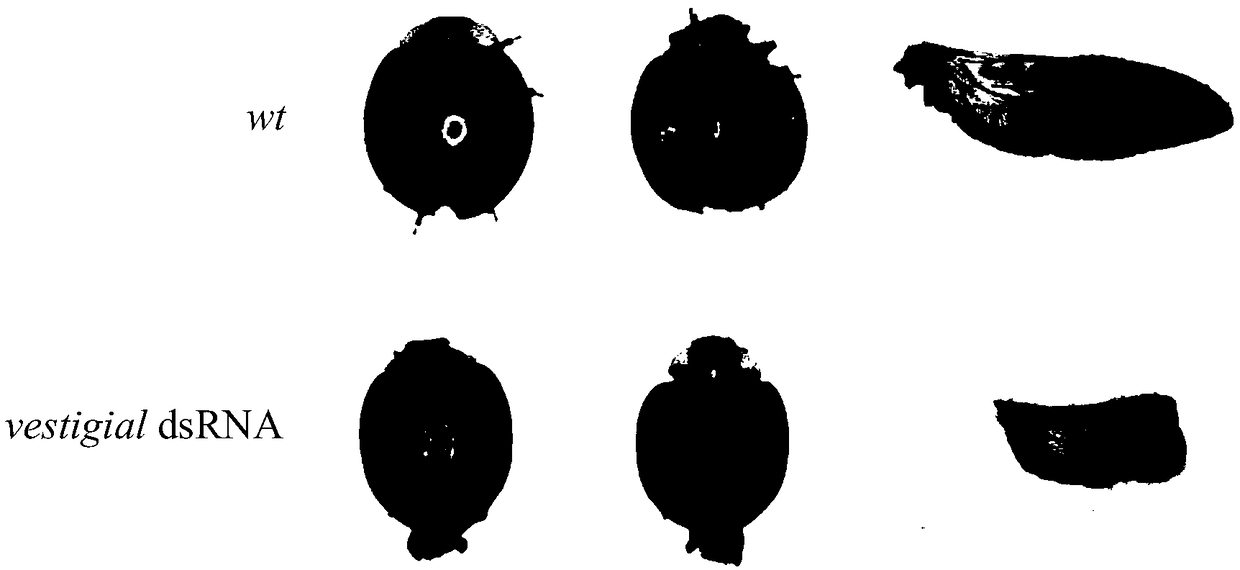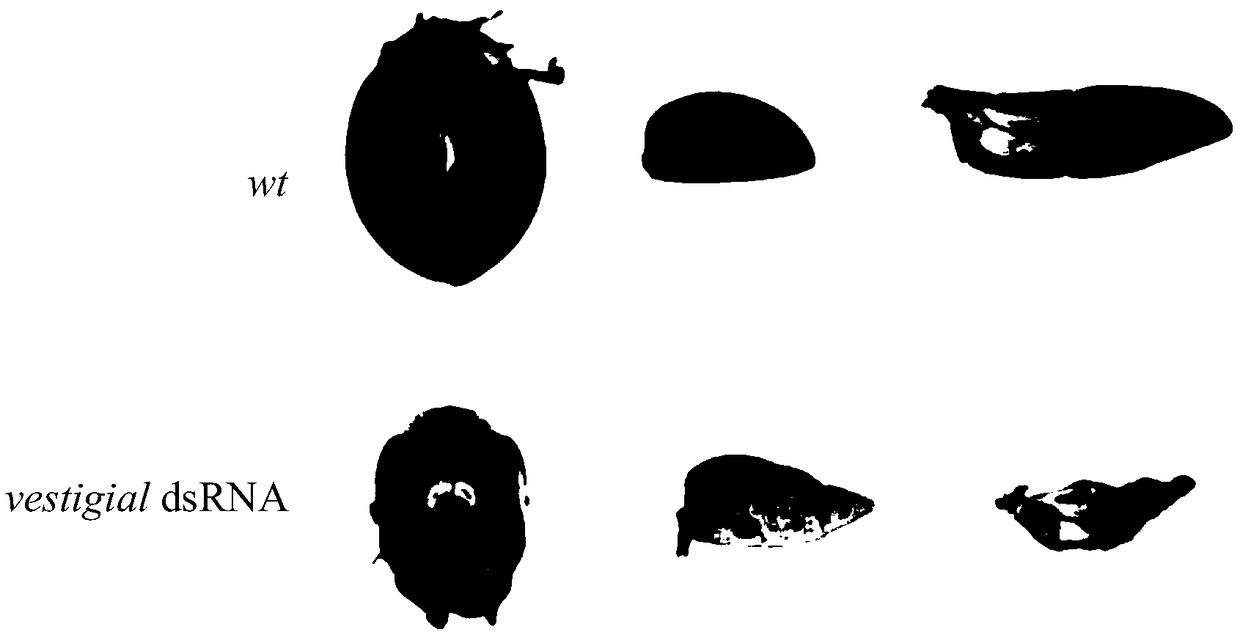Method of breeding non-flying Harmonia axyridis
A technology of ladybug and ladybug wings, applied in the field of bioengineering, can solve the problems of decreased viability and fecundity, unsuitable for field release, low flight ability, etc., to ensure large-scale cultivation, obvious social benefits and economic value, The effect of reducing economic costs
- Summary
- Abstract
- Description
- Claims
- Application Information
AI Technical Summary
Problems solved by technology
Method used
Image
Examples
Embodiment 1
[0046] Embodiments of the present invention provide a method for cultivating flightless ladybugs, specifically as follows:
[0047] 1. Raw materials
[0048] dsRNA: a vestigial dsRNA that interferes with the key genes of the wing development of the ladybug heterochromia.
[0049] According to the standard method for in vitro synthesis of dsRNA provided by Promega, dsRNA was synthesized using the T7RiboMAXExpress RNAi System kit provided by the company. The nucleotide sequence of dsRNA is shown in SEQ ID No.1.
[0050] 2. Method
[0051] The method for cultivating flightless ladybugs, the specific steps include:
[0052] (1) The dsRNA is prepared into a dsRNA solution with a concentration of 50.0 ng / ul;
[0053] (2) Take the larvae on the first day of the fourth instar, and inject 1 ul of the above-mentioned dsRNA solution from the third and fourth intersegmental membranes of the abdomen;
[0054] (3) Feed the larvae with aphids or artificial diet until it emerges, and obta...
Embodiment 2
[0056] Embodiments of the present invention provide a method for cultivating flightless ladybugs, specifically as follows:
[0057] 1. Raw materials
[0058] (1) Nano-carrier: The embodiment of the present invention takes the fluorescent nano-carrier molecule disclosed by CN103172776A as an example. The fluorescent nucleus inside the carrier has a high fluorescence quantum yield, good light, heat and chemical stability, which is beneficial to biological For in vivo tracking, a good cavity structure is formed between each side chain and a large number of specific functional groups are conducive to the binding and assembly of dsRNA molecules, and a stable dsRNA / nanocarrier complex is formed. The whole complex has good insect cell affinity. Harmony, which is conducive to the rapid entry of dsRNA molecules into cells to target target genes.
[0059] (2) dsRNA: a vestigial dsRNA that interferes with the key genes of the wing development of the heterochromia.
[0060] According to...
Embodiment 3
[0071] Embodiments of the present invention provide a method for cultivating flightless ladybugs, specifically as follows:
[0072] 1. Raw materials
[0073] (1) Nano-carrier: The embodiment of the present invention takes the fluorescent nano-carrier molecule disclosed by CN103172776A as an example. The fluorescent nucleus inside the carrier has a high fluorescence quantum yield, good light, heat and chemical stability, which is beneficial to biological For in vivo tracking, a good cavity structure is formed between each side chain and a large number of specific functional groups are conducive to the binding and assembly of dsRNA molecules, and a stable dsRNA / nanocarrier complex is formed. The whole complex has good insect cell affinity. Harmony, which is conducive to the rapid entry of dsRNA molecules into cells to target target genes.
[0074] (2) dsRNA: a vestigial dsRNA that interferes with the key genes of the wing development of the heterochromia.
[0075] According to...
PUM
 Login to View More
Login to View More Abstract
Description
Claims
Application Information
 Login to View More
Login to View More - R&D
- Intellectual Property
- Life Sciences
- Materials
- Tech Scout
- Unparalleled Data Quality
- Higher Quality Content
- 60% Fewer Hallucinations
Browse by: Latest US Patents, China's latest patents, Technical Efficacy Thesaurus, Application Domain, Technology Topic, Popular Technical Reports.
© 2025 PatSnap. All rights reserved.Legal|Privacy policy|Modern Slavery Act Transparency Statement|Sitemap|About US| Contact US: help@patsnap.com



